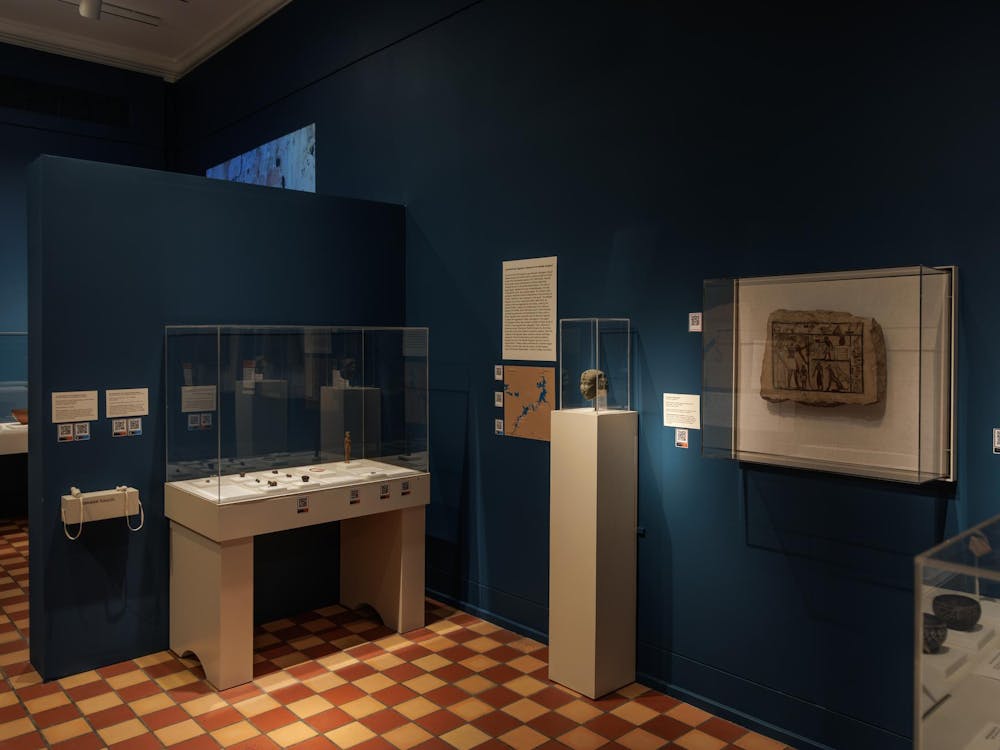Some days, Music Professor Matthew Burtner is out in the snow, recording the sounds of dripping water and crunching ice. Others, he is inside editing and arranging those sounds along with traditional instrumentation into a digital composition. Burtner works in the field of ecoacoustics — the study of environmental sounds.
As a composer, he takes these sounds of nature and creates music of all kinds. From opera to theater to film, Burtner has scored a variety of mediums. The intersections of science, policy and art are the core of Burtner’s work as a scorer and as a professor.
“Musicians play musical instruments, so performance with natural materials extends that to playing the sand or the water as the musical instrument,” Burtner said.
Burtner has three primary ways he composes. In some compositions he creates harmony and rhythm from scientific data in a process known as sonification. Another method, field recording, involves directly recording sounds outside. The third is performance with natural materials, which involves a person using natural material as if it were an instrument.
His role as a composer brings something unique to environmental activism through his collaborations with scientists and policymakers. Where environmental scientists and policymakers are gathering data and presenting information, Burtner is creating art that anyone can emotionally resonate with.
“[Science and policy] can be kind of challenged by their inability to engage normal listeners and viewers emotionally,” Burtner said. “Music can help create spaces where people could receive science and not be sort of turned away by it.”
In his piece for the 2012 Auksalaq Telematic Opera, he collected sounds from glaciers to create a soundtrack for a virtual theater performance about the melting ice caps.
The piece was the first telematic opera, where performers and audience members are located in multiple places and connected with one another virtually. It was streamed between concert halls in Washington, Norway, Montreal, Alaska, New York, Charlottesville and Indianapolis, with a shorter recorded version being streamed after the fact on National Geographic.
When it came to engaging with the audience for the Auksalaq piece, he used a software of his own creation called “Nomads” that allowed the audience to play dripping sounds from their phones. As more people joined the sounds gradually grew more plentiful and audible, outlining the story of society’s contributions to climate change.
“We're not just making a piece about the Arctic melting,” Burtner said. “We are melting the Arctic, we're doing it right now, and we're part of it. We're not separate from it.”
Burtner’s work also extends to the classroom. Since 2009, Burtner has been teaching MUSI 3400, “Ecoacoustics” at the University. In class, Burtner instructs students on the technicalities of recording, editing, composing and arranging, and discusses issues of environmental sustainability. Students from environmental science and engineering have been drawn to the course, and Burtner has adjusted it accordingly by giving students more freedom with their assignments and projects.
“Some students are working on more environmental science type projects using Creative Sound, and some are making more music compositions, and I let those things kind of coexist,” Burtner said. “The students collaborate together, which is really cool, because it kind of models what I'm doing outside.”
Just last summer, Burtner started another class — ETP 3500, “Sound and Sustainability,” a class that branches out more to encompass all kinds of sustainability from economic to social to environmental and how sound connects to those different subfields. Students work on self-driven, open-ended projects concerning whichever area they are most interested in.
“I love the opportunity to work with others on issues that are important to people,” Burtner said. “I'm always looking for those kinds of opportunities with music to reach out past the concert hall.”
Burtner noted that he does not just want to present music about the environment but also to get audiences and listeners involved. He wants them to connect with the art in a way that makes them think about the issues being presented.
This philosophy encompasses Burtner’s work as a professor. As he was teaching a class called MUSI 2350, “Technosonics: Digital Music and Sound Art Composition,” he used the “Nomads” software to allow his 300 students to connect to each other through their personal devices and manipulate sound. Every student would influence the sound a little bit, and they turned large lectures into a series of performance pieces where each person played a role in shaping how it played out.
“They could project notes and questions and do things on the screen while we were having class. That sort of thing didn't exist at the time,” Burtner said. “You had 300 people doing that, and it was just really cool.”
Burtner’s achievements do not stop there. He was awarded an Emmy in 2020 as the subject of Valerie Kern’s short film “Making Music with Glaciers and Snow.” It covers his work recording his album “Glacier Music,” which he describes as a “love song to the glaciers.”
Interdisciplinary collaboration is at the core of Burtner’s work as a composer as a professor, and at the core of how he seeks to make an impact on sustainability and climate change.
“It's when we combine our fields and we combine our research strengths that we can actually make change in the world,” Burtner said.







